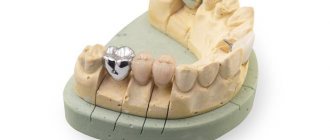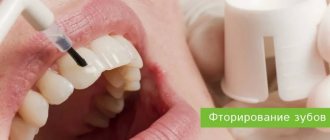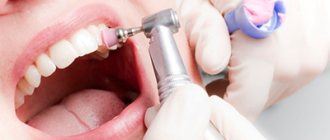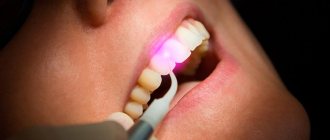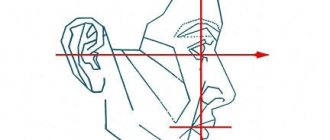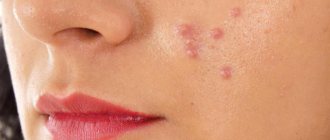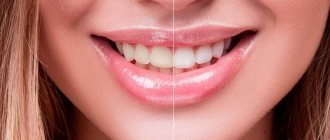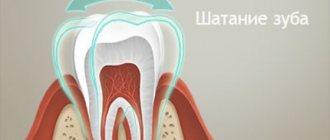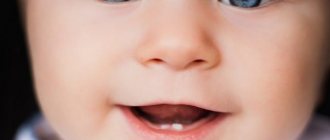In everything related to the care of young children, their health and development, every parent wants to rely on the advice of a competent specialist who has not only academic knowledge, but also real life experience.
Advice from Dr. Evgeniy Komarovsky was adopted by both young mothers who gave birth to their first child and grandmothers who raised more than one generation of children. They are reasonable, useful, quite applicable and really solve many problems and questions that inevitably arise in the process of raising a child.
How to help a child when cutting baby teeth, what symptoms you should be concerned about when teething, what can and should be done, and what will be useless and even harmful for the baby - below.
When teeth start cutting
There is no exact answer as to what time a child’s teeth are cut – the timing varies from person to person. However, you can focus on the average, standard periods of eruption approved by WHO:
- the lower incisors appear at 6–7 months;
- upper – at 7–8 months;
- upper lateral incisors – at 8–9 months;
- the lower ones are closer to a year.
According to the standard, a one-year-old child must have eight baby teeth.
From one year to one and a half years, the child acquires larger teeth - upper and lower molars, and from fifteen to twenty months - upper canines, which are also called “ocular.” The fact is that the optic nerve runs next to them, so these teeth are often more difficult for the child than others. Irritation of the nerve causes sharp pain and sometimes watery eyes.
It can be difficult even for a doctor to understand that the first teeth are being cut. After all, this process is often accompanied by an increase in temperature, changes in stool and mood, and refusal to eat.
Treatment of teeth grinding
If a baby grinds his teeth in his sleep, special treatment is not always needed. If a symptom of lower jaw tremor appears in a one-month-old baby, this is an alarming sign. The mother should pay attention to how the baby takes the breast, at what time the jaw spasm or trembling of the chin appears. A consultation with a neurologist is required. It is possible that during pregnancy or childbirth the baby suffered a brain injury or suffered from hypoxia.
When a 7-8 month old baby begins to grind his jaws, the pediatrician may recommend a gel for easy teething. Experienced mothers purchase cooling silicone teethers in advance, against which the infant scratches his gums.
If the analgesic effect of cooling or dental gel is insufficient, the baby is given paracetamol or ibuprofen syrup. They relieve inflammation from the gums, eliminate pain and swelling.
In autumn and winter, a 4-5 month old child experiences calcium deficiency. At this time of year, the number of sunny days decreases, and the need for the mineral increases. Calcium is absorbed from milk if there is enough vitamin D in the intestines. It is produced under the influence of ultraviolet radiation. If there is a lack of sunlight, the vitamin is low, so it is necessary to take it in the form of an aqueous solution of drops. Vitamin D will not harm a one-year-old baby or schoolchildren in the winter. The dosage of the drug is selected by the pediatrician individually, so as not to cause a state of hypervitaminosis, which is dangerous for the kidneys.
Treatment of creaking, which often appears after overexertion or stress, is carried out with sedatives. For children, the doctor may prescribe sedatives of herbal origin or herbal teas with mint, valerian, motherwort and other combinations.
If the pediatrician cannot determine why the child continues to grind his teeth, an examination by a dentist is necessary. The doctor will grind off the protruding fillings and check the function of the temporomandibular joint. For periodontal inflammation and caries, he will prescribe special treatment. An incorrect bite is a reason to contact an orthodontist. He will select a mouthguard to protect your tooth enamel from being worn away. If the bite is defective, the use of braces or a corrective plate will be required, which is removed at night.
If there is a repeated creaking or the appearance of convulsive contractions in other muscle groups, be examined by a neurologist. The result of the electroencephalogram may indicate a mild form of epilepsy. For treatment, the doctor will prescribe anticonvulsants. They will help reduce the frequency and severity of attacks. If you refuse therapy, this phenomenon will occur more often and more severely.
Formation of the dentition
The article tells how to understand that a child is teething, and about ways to help him with pain and inflammation of the gums. But first, a few words about the process of dentition formation.
The formation of absolutely all teeth occurs in the fifth month of intrauterine development. They remain in a “frozen” state and begin to grow immediately before eruption. Therefore, if a child has no teeth by 9-12 months, radiography is prescribed - a study that allows one to evaluate their formation and location.
How to alleviate the child's condition?
Mothers can alleviate the condition of their babies in the following ways:
- Massage. Before carrying out manipulations, you must wash your hands and treat them with an antiseptic solution. After this, you should stroke the gums with your thumb, index finger or little finger, gradually approaching the inflamed area. In this case, you need to focus on the child’s reaction. Movements should be light so as not to cause discomfort to the baby and not provoke the development of pain. The duration of the procedure takes no more than 20 minutes.
- Massage using a silicone finger brush.
- A massage that uses an ice cube previously wrapped in a piece of sterile cloth. This procedure should be performed at the site of swelling, no more than 5 minutes.
- Children can be given special teething toys that they will chew with pleasure.
You can alleviate the condition of a baby who is experiencing pain using medications:
- Medicines that have an anti-inflammatory effect. For example, "Cholisal", which is recommended to be used topically no more than twice a day. The baby may feel a burning sensation and salivation increases.
- Gels that have a cooling effect and contain lidocaine. You can alleviate the baby’s condition with the help of “Dentinox”, “Kalgel”, “Kamistad”. A drop of the gel should be applied to the inflamed gum, then spread the substance over the area of swelling with your finger or a cotton swab.
- Drops containing plant components. Such homeopathic remedies can eliminate painful sensations. They are recommended to be given to children between feedings, no more than three times a day. Their advantage is the almost complete absence of contraindications. Drops should not be used only if the baby has an individual intolerance to plant components.
- At high temperatures, mothers can give their children special suspensions “Nurofen” or “Panadol”. It is worth noting that acetylsalicylic acid is strictly contraindicated for children to lower their temperature.
To alleviate the condition of infants, it is recommended to use time-tested folk recipes:
- Natural honey (provided there is no allergy to this beekeeping product). A small amount of honey is applied to the inflamed gum and rubbed in with light movements. Additionally, the baby is given a teaspoon of sweet mass before bedtime.
- Baking soda. Prepare a solution: pour soda (1 tsp) into a container and add water (200 ml). A napkin is moistened in a soda solution and used to massage the area of swelling.
- Chamomile oil. It is recommended to rub it into the skin of the cheeks. You can also use chamomile infusion to treat the oral mucosa.
- Amber beads. They should be worn around the neck of infants. But, at the same time, parents must monitor their child at all times. Beads must be removed before night or daytime sleep.
- Valerian tincture. It should be rubbed into the inflamed areas of the gums. The healing liquid will relieve irritation and have an anesthetic effect.
- Tea made from lemon balm, lavender or chamomile. This drink will have a calming effect. Tea must be brewed strictly according to the instructions to avoid an overdose of herbal ingredients.
Do you want to know how to treat chronic tonsillitis in adults with folk remedies? Detailed information is presented in the article. You can read how speech therapy tongue massage is performed for children at home by following the link.
You can read about what disease a yellow tongue in a child indicates by following the link provided.
What affects the timing of teething?
Processes in the body are individual, including timing. The age at which the first teeth appear is determined by a number of factors:
- Heredity.
- The intrauterine period and negative factors affecting the fetus (for example, a pregnant woman taking certain medications).
- Nutrition for the expectant mother during the period of waiting for the baby and breastfeeding.
Introduction of complementary foods, etc.
What to do if the temperature rises?
During this difficult period for every baby, the mucous membranes in the oral cavity become inflamed. As a result, the body responds in the form of an increase in temperature.
If it does not exceed 38 degrees, then mothers should not worry, since the condition of their children should normalize naturally within a few days.
In the case when the temperature rises above 39 degrees, it may indicate the development of pathological processes and the children should be shown to pediatricians.
Do you want to know what the throat looks like with a sore throat in an adult? Then you just need to follow the link and read our article. If you are looking for information about what a person’s correct dental bite looks like, we advise you to follow the link.
The specialist will examine the young patient and prescribe an antipyretic drug.
Teething symptoms
- there may be a slight fever;
- anxiety - the child becomes capricious, sleeps poorly, often wakes up at night;
- decreased appetite;
- excessive salivation and, as a result, redness of the skin around the mouth;
- swelling and redness at the site of tooth eruption, possible formation of hematomas on the gum mucosa;
- increased need for the baby to chew on something: pacifier, toys, fingers.
There are children whose teeth appear asymptomatically and even unnoticed by their parents. But, as a rule, this process is accompanied by an individual combination of the signs given in the list above.
Complications
Babies may experience the following complications:
- A runny nose appears, which lasts no more than four days without treatment.
- The temperature rises to 39 degrees.
If the baby does not have any clinical manifestations indicating the development of the disease, then children's Paracetamol can be given.If the fever does not subside after two days, it is necessary to show the child to the pediatrician.
- Diarrhea. Parents need to understand that when diarrhea occurs, fluid is removed from the child’s body. To prevent life-threatening dehydration, they need to immediately replenish their water-salt balance.
How to brush a baby's teeth with a fingertip?
Using a fingertip or napkin is quite simple. The algorithm for brushing teeth for children under 6 months includes the following steps:
- Wrap the cloth around your little finger.
- Use gentle movements to clean your gums, as well as the inside of your cheeks and tongue.
- Using circular movements, treat the lower gum first and then the upper.
The time for cleansing the oral cavity depends on the emotional reaction of the baby. It is important not to overdo it with cleaning, so as not to disgust the baby.
Teeth cleaning for infants from 6 months to 1 year includes the following steps:
- Place a fingertip or napkin on your pinky or index finger.
- Brush your teeth in a circular, sweeping motion without applying pressure. Brush your teeth from the gums to the top.
- It is enough to massage the areas where teeth have not yet erupted for one minute.
- Use your example to show your child how to rinse his mouth with water. Over time, the baby will learn and begin to repeat this procedure after you.
The safety and long service life of the finger brush for infants will be ensured by compliance with the rules of its use:
- Before the first and each subsequent use, wash the brush in warm water with antibacterial or laundry soap.
- You should not boil fingertips that are not intended for this purpose, or put them in a microwave oven.
- After use, the brush should be dried naturally, holding it on a clean towel for 30-40 minutes.
- Before each use, be sure to check the integrity of the brush.
- Be sure to store the silicone fingertip separately from adult brushes, in a separate case.
- Finger brushes should be changed at least once every 2-3 months.
We hope that our recommendations for brushing teeth for infants will be useful to you. Remember, timely care of the baby’s teeth and gums using a fingertip or a special napkin will improve blood circulation in the gums and mucous membranes, eliminate stagnation in the gum tissue, strengthen them, and also prevent bleeding, swelling and inflammation of the tissues during teething.
Sources:
- Report on determining/confirming the preventive properties of toothpaste “ASEPTA PLUS” GENTLE WHITENING” Author: doctor-researcher A.A. Leontyev, head Department of Preventive Dentistry, Doctor of Medical Sciences, Professor S.B. Ulitovsky First St. Petersburg State Medical University named after. acad. I.P. Pavlova, Department of Preventive Dentistry
- Report on the determination/confirmation of the preventive properties of personal oral hygiene products “ASEPTA PLUS” Remineralization doctor-researcher A.A. Leontyev, head Department of Preventive Dentistry, Doctor of Medical Sciences, Professor S.B. Ulitovsky First St. Petersburg State Medical University named after. acad. I.P. Pavlova, Department of Preventive Dentistry
- Clinical experience in using the Asepta series of products Fuchs Elena Ivanovna Assistant of the Department of Therapeutic and Pediatric Dentistry State Budgetary Educational Institution of Higher Professional Education Ryazan State Medical University named after Academician I.P. Pavlova of the Ministry of Health and Social Development of the Russian Federation (GBOU VPO RyazSMU Ministry of Health and Social Development of Russia)
Treatment of caries in children under 3 years of age
The method of treating caries in children under 3 years of age depends on the stage of the disease, the individual characteristics of the child and, of course, his attitude towards dentists.
- At the stain stage, the doctor removes plaque and remineralizes the enamel using solutions or silvers the teeth.
- Superficial, medium and deep caries in children 1-3 years old (and older) are treated using a drill. If necessary, the doctor uses anesthesia. If a child suffers from aching toothache, canal depulpation is performed.
Remineralization
Remineralization is the restoration of damaged tooth enamel. To carry it out, the doctor cleans the surface of the affected area, and then covers the rows with a special composition with fluorine and calcium. The procedure is absolutely painless, most children tolerate it easily.
To avoid the development of caries in children, dentists recommend repeating remineralization every six months.
Silvering
This method enhances the protective abilities of enamel and is recommended for children who are afraid of dentists. The surface of the teeth is coated with silver nitrate. The substance provides a reliable antiseptic effect, but parents should be mentally prepared that after treatment the child’s teeth will turn black.
Sealing
For children over 1 year old, the dentist can fill damaged teeth. This treatment does not necessarily require the use of a drill. If the caries is shallow, the doctor applies a special solution with acid to the tooth. The substance corrodes the affected tooth surface, disinfects the carious cavity and applies photopolymer material.
If a child comes to the doctor with deep caries, it will not be possible to do without drilling. Before starting treatment, the doctor gives the baby anesthesia, since baby teeth have nerve endings.
Treatment of caries in children 2-3 years of age and older can be supplemented with procedures such as
- preparation or opening of a cleaned carious cavity;
- depophoresis – introduction of an electric current of copper-calcium hydroxide ions;
- ozone therapy - treatment of carious cavities using a jet of ozone gas;
- photodynamic therapy – application of a special medicinal paste to a carious tooth and subsequent laser treatment of the area.
When is there no reason to worry?
During the appearance of the first teeth, the baby’s behavior, as well as the reaction of the small organism, may change. The main symptoms are:
- Increased salivation . It is observed in almost all children. Saliva production increases from 10 weeks and lasts up to 4 months. At this time, it is enough for the young mother to prepare a set of bibs and change them regularly.
- Skin irritation on the chin and around the mouth. The cause of this phenomenon is the aforementioned excessive salivation. To avoid irritation, you need to wipe your baby's face with gentle movements and regularly apply a little emollient cream to the skin. It is best to use it before bed, so that the product is completely absorbed.
- While feeding a baby who has started teething, the mother experiences discomfort as the baby tries to bite the nipple . This is explained by the fact that the baby wants to scratch his gums, which is why he squeezes any objects.
